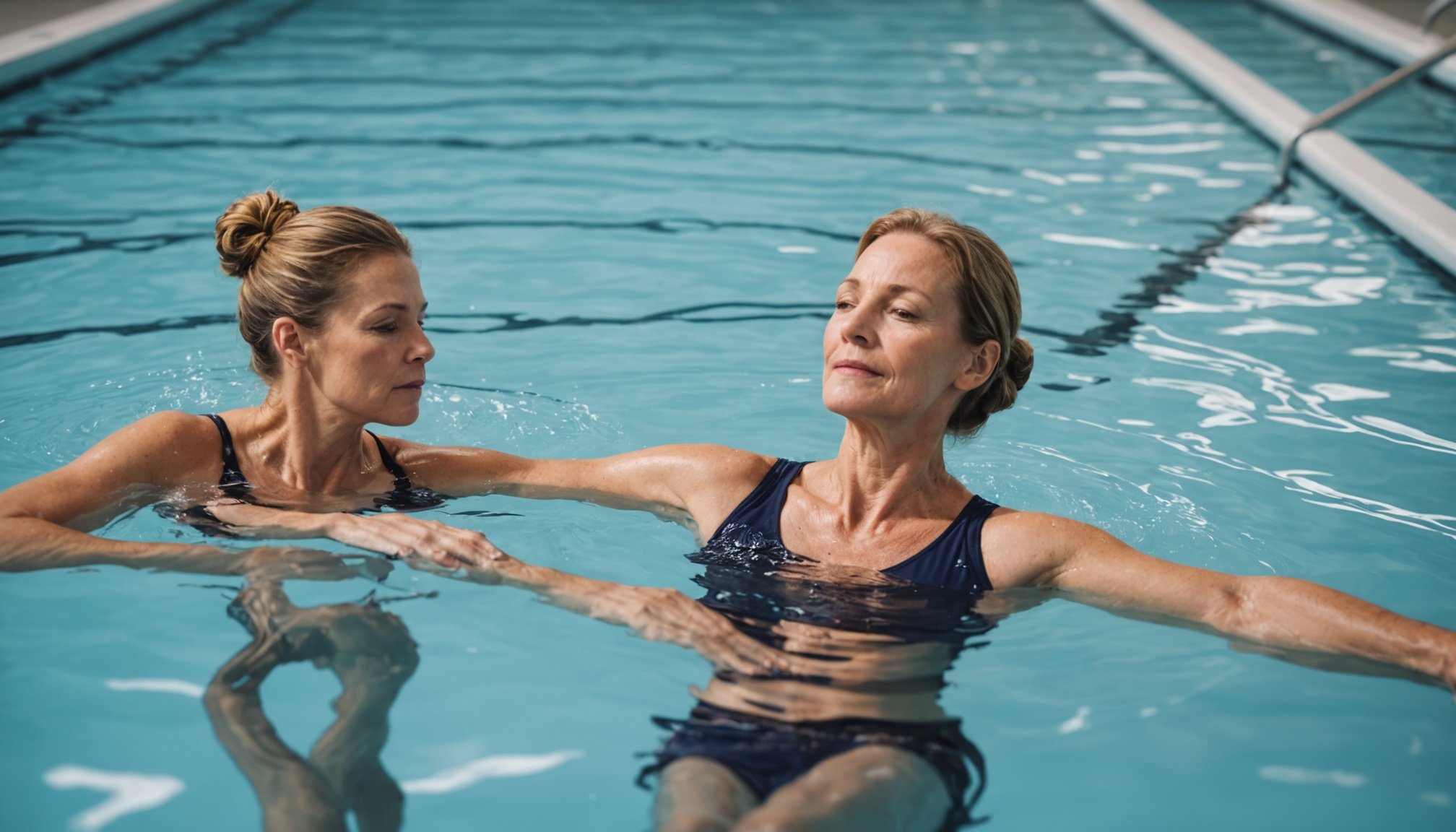Understanding Hydrotherapy
Hydrotherapy, a treatment utilizing water for healing purposes, traces its origins back to ancient civilizations, where it was revered for its therapeutic properties. Rooted in practices from ancient Greece and Rome, it has evolved significantly over the centuries, maintaining a steadfast role in modern healthcare due to its effective healing mechanisms.
Central to hydrotherapy are various techniques that leverage water’s dynamic qualities. For instance, aquatic exercises are often recommended for individuals seeking low-impact fitness routines. These exercises, performed in a pool, harness water’s buoyancy to reduce strain on joints, making them ideal for rehabilitation. Another common method involves warm baths, which are renowned for their ability to induce relaxation and alleviate muscle tension.
Also to read : Exploring the Impact of a Gluten-Free Diet on Autoimmune Thyroid Disease Symptoms: Can It Make a Difference?
Hydrotherapy works through multiple mechanisms to facilitate pain relief and relaxation. The warmth of water not only soothes the muscles but also improves circulation, which aids in reducing inflammation. Meanwhile, water’s pressure can assist in massaging the body, offering a gentle but effective way to relieve discomfort. Ultimately, these techniques serve not only physical well-being but also contribute to mental relaxation, providing a holistic approach to health.
Hydrotherapy Techniques for Chronic Fatigue Syndrome
Exploring hydrotherapy techniques can offer effective relief for those suffering from Chronic Fatigue Syndrome (CFS). By incorporating various aquatic methods, individuals can target fatigue and improve their overall well-being.
Additional reading : Does Advanced UV Filtration in School Environments Lower Childhood Asthma Attack Rates?
Aquatic Exercises
Aquatic exercises are particularly beneficial for CFS patients, offering a low-impact workout that reduces strain on the body while enhancing circulation and providing gentle resistance. This environment makes it easier for joints and muscles to move, thus helping reduce stiffness and pain. Suitable exercises include water walking, gentle swimming, or water aerobics, which can be tailored to individual comfort levels. Regular sessions are recommended, ideally two to three times a week, lasting 20 to 30 minutes each. This frequency can boost energy levels and improve mood, with the water providing a soothing, supportive element that encourages persistence without overexertion.
Warm Baths
The physiological effects of warm baths are significant in managing CFS symptoms. Immersing oneself in warm water can enhance circulation and stimulate muscle relaxation, which can lead to decreased fatigue and improved mood. The heat from the bath promotes the release of endorphins, the body’s natural painkillers, which contribute to emotional well-being. However, it’s crucial to ensure water temperature is moderate to avoid hypotension. Sessions should last around 15 to 20 minutes to maximise benefits without causing additional fatigue.
Evidence Supporting Hydrotherapy for CFS
Research into the effectiveness of hydrotherapy for chronic fatigue syndrome (CFS) relief has yielded promising results. Several scientific studies have examined hydrotherapy’s impact on CFS, demonstrating improvements in both physical function and fatigue levels. For instance, one study highlighted that participants experienced a marked decrease in fatigue and an increase in quality of life after engaging in a structured hydrotherapy program.
Personal testimonies and case studies further underscore hydrotherapy’s potential benefits. Individuals with CFS have reported symptom relief, improved mood, and enhanced energy levels post-treatment. These accounts, while anecdotal, provide valuable insights into the positive outcomes some patients experience.
Despite these encouraging findings, researchers acknowledge certain limitations in the current body of evidence. Many studies involve small sample sizes or lack control groups, which can affect the robustness of the results. Additionally, the variations in therapy protocols and participant characteristics make it difficult to establish a standardised treatment framework.
Overall, while hydrotherapy holds promise as a complementary treatment for CFS, further research with larger sample sizes and rigorous methodologies is necessary to solidify its position as an effective intervention.
Comparing Hydrotherapy with Other Treatments for CFS
Exploring various treatment options for Chronic Fatigue Syndrome (CFS) is crucial for effective management. Among these, hydrotherapy stands out due to its holistic nature, but how does it measure up against more traditional methods and alternative therapies?
Traditional Treatment Modalities
Standard treatment options for CFS often include medication, such as antidepressants, and cognitive behavioural therapy (CBT). These aim to manage symptoms like fatigue and improve quality of life. However, they frequently come with side effects ranging from mild (e.g., nausea) to more severe impacts on mental health. In contrast, hydrotherapy presents itself as a low-risk alternative, focusing on reducing muscle pain and improving sleep patterns without pharmacological interventions.
Alternative Therapies
CFS sufferers often explore alternative therapies like acupuncture and yoga to enhance wellbeing. Acupuncture may alleviate pain, while yoga promotes relaxation and stress reduction, making it a beneficial addition to a patient’s routine. Holistic approaches, which integrate hydrotherapy, can further amplify these effects. By combining these modalities, individuals might achieve improved balance, reduced stress, and enhanced energy levels. This creates a comprehensive care plan that addresses not just the symptoms, but overall wellbeing, making hydrotherapy a potentially favorable companion in treating CFS.
Potential Risks and Considerations
While hydrotherapy offers numerous benefits, it is essential to be aware of potential risks. These could range from mild to severe, depending on individual health conditions or therapist expertise. For example, individuals with cardiovascular issues may experience adverse effects due to water pressure and temperature, which can affect heart rate and blood pressure.
Before starting hydrotherapy, one must consider specific contraindications. People with open wounds, severe skin conditions, or infections might risk worsening their conditions through water exposure. Pregnant women and individuals with kidney conditions should also consult healthcare professionals to assess any contraindications.
To ensure safety, practitioners and users must observe various safety measures. These include conducting a thorough medical evaluation prior to commencing therapy and adjusting water temperature and pressure to suit individual needs. Proper supervision by qualified professionals can further reduce risks.
Adopting best practices like using sanitized equipment and monitoring the client’s response during therapy can mitigate potential risks. It’s crucial to prioritize these considerations for an effective and safe hydrotherapy experience.
Finding Practitioners and Facilities for Hydrotherapy
Embarking on a journey to locate qualified practitioners and appropriate facilities for hydrotherapy requires thoughtful consideration. Begin by researching practitioners who are properly certified. Look for credentials from reputable organisations and feedback from past clients to ensure a trustworthy professional.
When it comes to finding the right facilities, seek out wellness centres that provide comprehensive services. Many such centres specialise in hydrotherapy, offering various treatment options tailored to your needs. Visiting these locations beforehand is advisable to assess the quality of care they provide.
To ensure reputable hydrotherapy services, several resources are available. Online directories and health websites often have detailed listings of practitioners and facilities. Checking these resources can aid in verifying credentials and the available services. Networking with healthcare professionals or joining support groups may also uncover additional options, as personal recommendations often prove invaluable.
Consider your personal requirements and geographic location to streamline your search for practitioners and facilities. With a well-informed approach, finding the right hydrotherapy solution can significantly enhance your wellness journey. By focusing on educated choices, you can confidently proceed with selecting services that meet both your expectations and needs.











